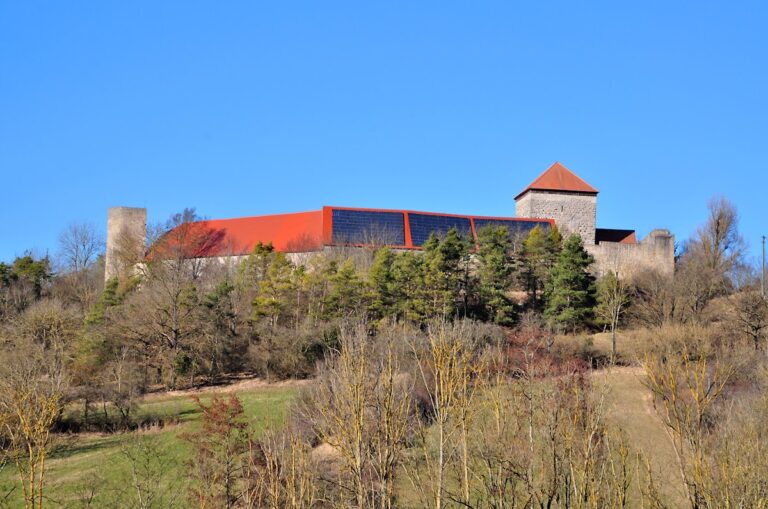Burgruine Speckfeld: A Medieval Castle Ruin near Markt Einersheim, Germany
Visitor Information
Google Rating: 4.4
Popularity: Low
Google Maps: View on Google Maps
Official Website: de.wikipedia.org
Country: Germany
Civilization: Unclassified
Remains: Military
History
Burgruine Speckfeld is a castle ruin located near Markt Einersheim in Germany, built by members of the noble family known as the Edelherren von Speckfeld around the year 1200. This hilltop fortress, positioned on the wooded Schlossberg hill, was established during the medieval period by a lineage that had roots tracing back to the Edelfreien von Uffenheim, a prominent noble house documented from the mid-12th century.
During the 14th century, control over the castle shifted to ecclesiastical authorities, namely the bishops of Würzburg and Bamberg. In 1306, records show that a representative from the Hohenlohe family acted as bailiff, managing the estate. The castle also served a domestic role in that era, becoming the residence of Elisabeth von Hohenlohe between 1370 and 1384. However, the castle’s governance was not without conflict, as evidenced in 1399 when Johann von Hohenlohe faced temporary confiscation of the site on charges related to highway robbery.
By the early 15th century, ownership transitioned through marriage and inheritance to other noble families. In 1412, Count Leonhard von Castell and Schenk Friedrich von Limpurg, brothers-in-law of Johann von Hohenlohe, assumed possession. The Limpurg family consolidated control by 1435, maintaining the property well into the early 18th century. A significant moment in the castle’s history occurred on May 16, 1525, when it was destroyed during the widespread Peasants’ War uprising. This destruction led to subsequent rebuilding efforts, including recovery from a destructive fire in 1558 that damaged parts of the north and east structures. Repairs were completed by 1580.
Throughout the Thirty Years’ War from 1618 to 1648, the castle endured repeated plundering by both Swedish forces and Imperial troops, yet restoration work was undertaken in 1624 to maintain its defenses and habitability. The late 17th century marked the beginning of the castle’s decline as Vollrath Schenk zu Limpurg-Speckfeld relocated his residence to nearby Einersheim in 1693, effectively abandoning the castle as a seat of power. Following matrimonial ties in 1711, the property passed to the Rechteren-Limpurg-Speckfeld family. Subsequently, the castle was left to deteriorate, undergoing partial demolition and serving as a source of building material for the surrounding area.
Since 1991, efforts have been made to preserve the remaining structures, with the Bavarian State Forests overseeing restoration. The ruins are now officially protected as both a historic and archaeological site under the care of Bavarian heritage authorities.
Remains
The ruins of Burgruine Speckfeld retain several notable architectural elements that reflect its medieval origins and subsequent modifications. Positioned atop the forested Schlossberg hill, the castle ruins integrate naturally with the surrounding landscape within the Speckfeld Nature Forest Reserve. Its layout was designed to fit the hilltop’s contours and included defensive features typical of medieval fortifications.
A prominent surviving wall stands approximately 15 meters tall and showcases a gate archway accompanied by three window openings. This structure marks part of the entrance zone and gives insight into the castle’s original defensive and residential functions. Nearby, there remains a side wall of the gate tower, known as a bergfried. The bergfried was a central tower commonly used in German castles for both lookout and last-resort refuge, indicative of the castle’s fortified character.
Within the ruins are remnants of the castle cellar and fragments of small vaulted spaces, which would have served as storage or support rooms in the original design. An original well is still visible on the site, underscoring the castle’s self-sufficiency in water supply during its period of occupation. Surrounding much of the structure, a moat can be clearly discerned on three sides, serving as an additional defensive barrier against assailants. Its complete form is still marked by the earthworks preserved around the ruins.
Together, these surviving features offer a tangible connection to the castle’s layered history of construction, destruction, and reconstruction spanning several centuries. Conservation efforts have stabilized the remaining walls and ensured these elements remain accessible to study and appreciate within their wooded setting.










